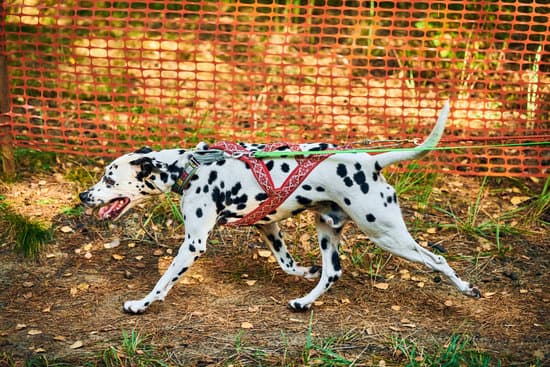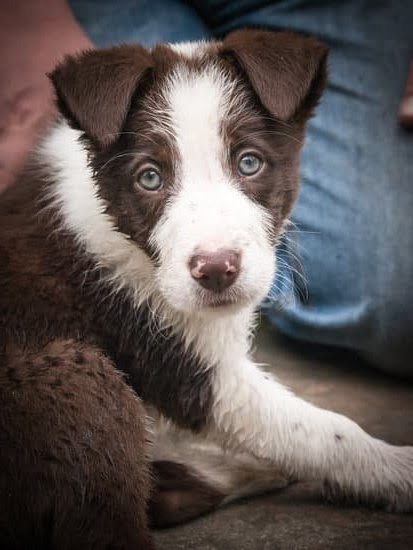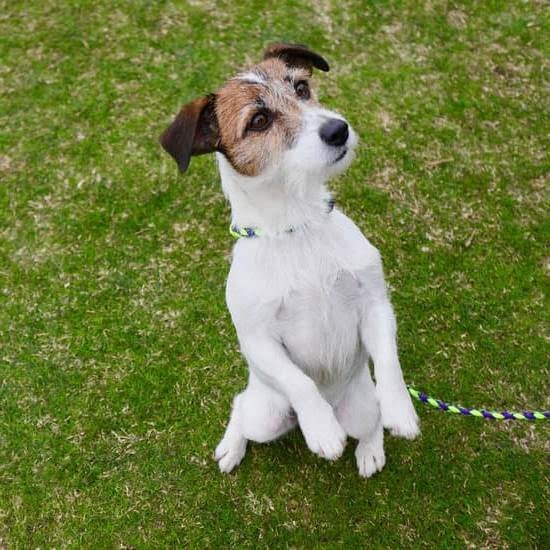Jumping up is a common and disruptive behavior exhibited by large dogs, but it can be trained out of them. This article will delve into the significance of training a large dog not to jump up, exploring its potential dangers and the benefits of curbing this behavior. By establishing a strong foundation through basic obedience training and implementing positive reinforcement techniques, owners can effectively teach their dogs not to jump.
Consistency and gradual exposure are crucial in the training process, along with distractions and redirecting techniques. Seeking professional help or resources may also be necessary for challenging cases. Overall, training a large dog not to jump up creates a safer and more enjoyable environment for both the dog and its owners.
The Root Cause of Jumping Up Behavior in Large Dogs
Large dogs tend to have a natural inclination to jump up on people, but it’s important for owners to understand the root cause of this behavior in order to effectively address it. There are several factors that contribute to why large dogs jump up, including instinctual behavior, excitement, attention-seeking, and dominance.
One of the main reasons why large dogs may jump up is due to their instinctual nature. Dogs are pack animals and jumping up could be seen as a way for them to establish dominance or assert their position within the pack.
In the wild, dogs often greet each other by sniffing and licking each other’s faces. When a dog jumps up on a person, it may be trying to get closer to their face in an attempt to establish a connection or show submission.
Excitement is another common factor that leads to jumping up behavior in large dogs. Dogs can become easily excited when they see someone they know or when something exciting is happening around them. Jumping up can be a way for them to release their pent-up energy and express their enthusiasm. However, this behavior can become problematic as large dogs may unintentionally knock over small children or elderly individuals.
Attention-seeking is another reason why large dogs may jump up on people. Dogs crave attention and jumping up can be an effective way for them to get noticed and receive affection from their owners or guests. If they are consistently rewarded with attention when they jump up, they will continue engaging in this behavior as it has proven successful in getting what they want.
In summary, understanding the root cause of jumping up behavior in large dogs is crucial in addressing and modifying this unwanted behavior. By recognizing instinctual behaviors, excitement triggers, and attention-seeking tendencies, owners can implement training techniques specifically tailored to their dog’s needs in order to curb jumping up habits effectively.
The Negative Impacts of Allowing a Large Dog to Continue Jumping Up
Allowing a large dog to continue jumping up can have various negative impacts, both for the dog and the people around them. One of the most significant consequences is the potential for injuries. When a large dog jumps up on someone, especially if they are not expecting it or lack the physical strength to withstand it, accidents can happen. A person may lose their balance and fall, resulting in sprains, bruises, or more serious injuries like fractures.
In addition to human injuries, a jumping dog can also harm themselves. If they jump up on surfaces that are unstable or slippery, they can easily slip and injure themselves. There have been instances where dogs have jumped up on furniture and accidentally fallen off, leading to broken bones or other injuries.
Allowing a large dog to jump up on guests or visitors can create an uncomfortable experience for them as well. Not everyone is comfortable with dogs jumping on them, especially if they are unfamiliar with dogs or have had negative experiences in the past. This discomfort can lead to tension between the dog’s owners and their guests.
Furthermore, a persistently jumping dog may garner a negative reputation among neighbors or within the community. People may perceive the owner’s inability to control their dog as a sign of negligence or lack of proper training. This negative perception can strain relationships with neighbors and even result in complaints filed against the owner.
It is essential for owners of large dogs to recognize these negative impacts and take action by training their dogs not to jump up. By doing so, they create a safer environment for everyone involved while also promoting positive interactions between their pets and others.
Establishing a Strong Foundation through Basic Obedience Training
Basic obedience training is an essential foundation for addressing jumping up behavior in large dogs. By teaching your dog basic commands such as “sit,” “stay,” and “down,” you establish a clear line of communication and create a framework for enforcing boundaries and expectations. This section will explore the importance of basic obedience training as a prerequisite for addressing jumping up behavior.
The Importance of Basic Obedience Training
Before attempting to address the jumping up behavior, it is crucial to ensure that your dog has a solid grasp of basic obedience commands. These commands provide your dog with structure, discipline, and guidance, which are imperative in curbing unwanted behaviors. They also promote impulse control and teach your dog patience and self-restraint.
By practicing basic obedience training with your large dog, you establish yourself as the leader or alpha in the relationship. Dogs naturally seek a hierarchy within their pack, so when they understand that you are the one in charge and follow your instructions, they feel more secure and less inclined to exhibit problematic behaviors like jumping up.
Essential Commands for Curbing Jumping Up
There are several fundamental commands that can aid in curbing jumping up behavior in large dogs:
- Sit: Teaching your dog to sit on command provides them with an alternative behavior to jumping up. Start by holding a treat close to their nose and raise it slowly while guiding their bottom down into a seated position. Reward them with praise or a treat when they successfully sit on command.
- Stay: Teaching your dog to stay helps reinforce self-control and prevents impulsive behaviors like jumping up. Begin by having your dog sit or lie down, then take a step back while using the hand signal for stay (an open palm). Gradually increase the distance between you and your dog while steadily increasing the duration of the stay before releasing them.
- Down: The “down” command is useful when your dog tries to jump up on people. By teaching them to lie down, you redirect their energy and discourage jumping up. Start with your dog in a sitting position, then lower the treat to the ground while giving the command “down.” Reward them when they successfully lie down.
By mastering these basic obedience commands, your large dog will be better equipped to understand and follow your instructions, making it easier to redirect their behavior away from jumping up. Remember, consistency and repetition are key when it comes to obedience training, so practice these commands regularly and consistently reinforce them with rewards and praise.
Implementing Positive Reinforcement Techniques for Training a Large Dog Not to Jump Up
Training a large dog not to jump up can be accomplished effectively through the use of positive reinforcement techniques. Positive reinforcement training is based on rewarding desired behaviors and ignoring or redirecting unwanted behaviors without the use of punishment. This method focuses on building a strong bond between the dog and its owner, promoting a positive learning experience for both.
To begin implementing positive reinforcement techniques, it is important to first identify what motivates your dog. This could be treats, toys, verbal praise, or a combination of these rewards. Once you have determined your dog’s motivation, you can proceed with the following step-by-step instructions:
- Set clear expectations: Clearly communicate to your dog that jumping up is not acceptable behavior. Use consistent commands such as “off” or “down” to establish boundaries.
- Reward desired behavior: When your dog approaches you calmly with all four paws on the ground, immediately provide praise and rewards. This could be in the form of verbal praise or a small treat.
- Ignore jumping up behavior: If your dog jumps up on you or others, withhold attention by turning away and avoiding eye contact. By removing all forms of attention, you are discouraging this undesirable behavior.
- Redirect and reinforce alternative behavior: Teach your large dog more appropriate ways to greet people by redirecting their attention. As soon as they start jumping up, command them to sit or offer a paw instead. Reward them when they follow these commands successfully.
Consistency is key when using positive reinforcement techniques for training a large dog not to jump up. Be patient and dedicated in consistently rewarding desired behavior while ignoring and redirecting jumping up behavior. By doing so, your large dog will learn that keeping all four paws on the ground earns them attention and rewards.
| Positive Reinforcement Techniques | Steps |
|---|---|
| Set clear expectations | Clearly communicate boundaries and use consistent commands. |
| Reward desired behavior | Praise and reward your dog immediately when they approach calmly with all paws on the ground. |
| Ignore jumping up behavior | Withhold attention by turning away and avoiding eye contact when your dog jumps up. |
| Redirect and reinforce alternative behavior | Teach your dog more appropriate ways to greet people, such as sitting or offering a paw. |
Consistency and Repetition
Consistency and repetition are key elements in successfully training a large dog not to jump up. Dogs thrive on routine and clear expectations, so it is crucial for everyone in the household to adhere to the same training methods and expectations. By providing consistent guidelines and reinforcing desired behavior repeatedly, your large dog will begin to understand what is expected of them.
One way to maintain consistency is through using the same verbal cues and body language when training your dog. For example, if you want your dog to sit instead of jumping up, consistently use the command “sit” while simultaneously using a hand signal like raising your palm towards them. By consistently using these cues every time your dog jumps up, they will start associating these signals with the desired behavior of sitting.
Repetition is another important aspect of training a large dog not to jump up. Just like humans, dogs learn through repetition and practice. It may take multiple repetitions of a command or scenario for your dog to fully grasp what is expected of them. Be patient and continue practicing regularly until they consistently respond correctly.
In addition to consistency and repetition, positive reinforcement plays a vital role in training a large dog not to jump up. When your dog displays the desired behavior of staying down instead of jumping up, reward them immediately with praise, treats, or playtime. Positive reinforcement helps reinforce good behavior and encourages your dog to continue behaving appropriately.
By combining consistency, repetition, and positive reinforcement techniques in your training sessions with your large dog, you are more likely to achieve success in curbing their jumping up behavior. Remember that training takes time and patience, so be consistent in practicing these techniques daily. Eventually, with enough practice and reinforcement, your large dog will learn that staying down is the preferred behavior when interacting with people.
Gradual Exposure and Controlled Training Scenarios
Gradual Exposure to Triggers
When training a large dog not to jump up, it is essential to expose them gradually to the triggers that cause this behavior. This could include visitors entering the home, exciting activities such as playtime or walks, or even encountering other animals outside. By slowly exposing your dog to these situations, you can better manage their behavior and effectively train them not to jump up.
To begin, start with controlled scenarios where the triggers are minimal. For example, invite a trusted friend or family member who is familiar with your dog’s jumping tendencies to assist in the training process. Start by having them enter the home while your dog is on a leash and giving them commands such as “sit” or “down.” If your dog remains calm and does not attempt to jump up, reward them with praise and treats.
Creating Controlled Training Scenarios
As your dog becomes more comfortable with controlled scenarios, gradually increase the difficulty level of the training. This can be done by introducing more people into the environment or engaging in higher-energy activities. It’s important to remain patient during this process and recognize that each dog learns at their own pace.
One effective technique is incorporating obedience commands during these controlled scenarios. For instance, when someone enters the home, instruct your dog to sit or lie down before allowing them to greet the visitor. Consistently reinforce this behavior with rewards whenever they follow through successfully. This helps redirect their attention away from jumping up and teaches them an alternative, more desirable behavior.
Consistency and Reinforcement
Consistency is key when implementing gradual exposure and controlled training scenarios. Ensure that everyone in your household follows the same training methods and expectations for your dog’s behavior. Inconsistencies can confuse your pet and hinder progress.
Remember, positive reinforcement plays a crucial role in training a large dog not to jump up. Reward your dog with treats, verbal praise, and physical affection when they exhibit the desired behavior of not jumping up. By consistently rewarding this positive behavior, you are reinforcing that it is the preferred action.
Using Distractions and Redirecting Techniques to Prevent Jumping Up
Large dogs jumping up on people can be a frustrating and potentially dangerous behavior. Fortunately, there are effective training techniques that can help prevent this behavior and promote a more enjoyable environment for both the dog and its owners. One effective approach is to use distractions and redirecting techniques to discourage jumping up.
One way to prevent jumping up is to provide the dog with an alternative behavior to engage in instead. This can be achieved by using distractions such as toys or treats to redirect their attention. When the dog starts to jump up, quickly divert their focus by presenting a toy or treat.
Once they are engaged with the distraction, praise and reward them for their good behavior. This teaches the dog that engaging in alternative behaviors like playing with a toy or sitting calmly will result in positive reinforcement.
Another technique is to teach the dog a specific command or cue that they can follow when they feel the urge to jump up. For example, you can train your dog to “sit” or offer a paw instead of jumping. By consistently reinforcing this desired behavior through positive reinforcement, the dog will learn that sitting or offering a paw is more rewarding than jumping up.
Consistency is key when using distractions and redirecting techniques. Everyone in the household should be on board with implementing these techniques and consistently reinforcing them. It’s important to remember that training takes time and patience, so it’s crucial not to get discouraged if progress is slow at first.
In summary, using distractions and redirecting techniques can be highly effective in preventing large dogs from jumping up on people. By providing them with an alternative behavior and consistently reinforcing it through positive reinforcement, you can help create a well-behaved and balanced life with your trained large dog.
| Techniques | Description |
|---|---|
| Use Distractions | Quickly divert the dog’s attention with toys or treats when they start to jump up. |
| Redirect with Alternative Behaviors | Teach the dog commands like “sit” or offering a paw as an alternative to jumping up. |
| Consistency and Positive Reinforcement | Ensure everyone in the household is consistent in implementing these techniques and reinforce desired behavior with rewards and praise. |
Utilizing Professional Help and Resources
When training a large dog not to jump up becomes challenging or overwhelming, it is important to know that professional help and resources are available. Seeking assistance from a qualified dog trainer or behaviorist can provide valuable guidance and expertise in addressing this issue effectively.
Professional trainers have the knowledge and experience necessary to assess your specific situation and develop an individualized training plan for your dog. They can identify the root causes of the jumping up behavior and tailor their approach accordingly. With their expertise, they can guide you in implementing appropriate training techniques, ensuring both the safety of your dog and the effectiveness of the training process.
Dog training classes are also a great resource for addressing jumping up behavior in large dogs. These classes offer structured environments where dogs can learn alongside other dogs, providing opportunities for socialization while working on obedience skills. Not only will these classes provide guidance on addressing jumping up specifically, but they also cover essential commands and behaviors that contribute to creating a well-behaved canine companion.
In addition to professional help, there are also numerous resources available that can assist in training your large dog not to jump up. Books, online articles, videos, and forums offer a wealth of information on effective training methods and tools. However, it is crucial to ensure that you rely on reputable sources when accessing these resources.
By utilizing professional help and resources, you increase your chances of successfully curbing your large dog’s jumping up behavior. Remember that every dog is unique and may require different approaches or combinations of techniques. Embrace the guidance provided by professionals and educate yourself with reliable resources to create a safe, harmonious environment for both you and your beloved pet.
Conclusion
In conclusion, training a large dog not to jump up is crucial for creating a safe and enjoyable environment for both the dog and its owners. The disruptive behavior of jumping up can be a nuisance and even potentially dangerous, making it essential to address this issue. By understanding the root causes of jumping up behavior in large dogs, such as excitement or seeking attention, owners can take effective steps to curb this behavior.
Allowing a large dog to continue jumping up can have negative impacts on both humans and the dog itself. Potential injuries, damage to property, discomfort for guests, and a negative perception of the dog’s behavior are all consequences that can arise from not training the dog properly. That is why establishing a strong foundation through basic obedience training is crucial. Basic commands like “sit,” “stay,” and “down” can help redirect a large dog’s behavior and discourage jumping up.
Implementing positive reinforcement techniques consistently and repetitively is key to success in training a large dog not to jump up. Through gradual exposure to triggers that cause jumping up and controlled training scenarios, owners can effectively modify their dog’s behavior over time. By using distractions and redirecting techniques such as toys or treats, owners can divert their dog’s attention away from jumping up.
While some cases may require professional help, following the techniques provided in this article can greatly improve a large dog’s behavior. The process takes time and patience but is well worth the effort. Training a large dog not to jump up promotes harmony and safety in the household, creating a balanced life where both owners and their furry companions can enjoy each other’s company without any disruptive or potentially dangerous behaviors.
Frequently Asked Questions
Can dogs be trained not to jump?
Dogs can absolutely be trained not to jump, although it requires consistent and patient training. Jumping is a natural behavior for dogs to seek attention or express excitement, but it can become problematic if not properly managed. The key to training dogs not to jump is consistency in reinforcing alternative behaviors, such as sitting or staying on command.
This can be achieved through positive reinforcement techniques like rewarding calm behavior and ignoring jumping. Consistent training sessions and clear communication are crucial for teaching dogs that keeping all four paws on the ground is more desirable.
What to do when a large dog jumps on you?
When a large dog jumps on you, it’s important to remain calm and avoid any visible signs of fear or distress. Although it may be inconvenient or uncomfortable, reacting strongly by shouting or pushing the dog away can inadvertently reinforce their jumping behavior. Instead, try stepping backward or turning your body slightly sideways as soon as the dog tries to jump.
Crossing your arms and avoiding eye contact is also helpful in conveying a calm and assertive demeanor. Additionally, redirecting their attention by asking them to sit or providing an alternative outlet for their energy like playing with a toy can be effective means of discouraging excessive jumping.
Is it bad for big dogs to jump?
It can have detrimental effects on big dogs’ health when they repeatedly engage in excessive jumping. The sheer weight and size of larger breeds pose higher risks compared to smaller dogs while engaging in this behavior frequently over time. Jumping puts significant strain on their joints, muscles, and ligaments, potentially leading to injuries like sprains or even more severe joint problems such as hip dysplasia or arthritis later in life.
Moreover, continuous jumping could create stress on their skeletal structure which might result in long-term damage, especially if they land incorrectly repeatedly from elevated surfaces like furniture or vehicles. Therefore, it’s important to manage and discourage jumping habits for the overall well-being of big dogs.

Welcome to the blog! I am a professional dog trainer and have been working with dogs for many years. In this blog, I will be discussing various topics related to dog training, including tips, tricks, and advice. I hope you find this information helpful and informative. Thanks for reading!





